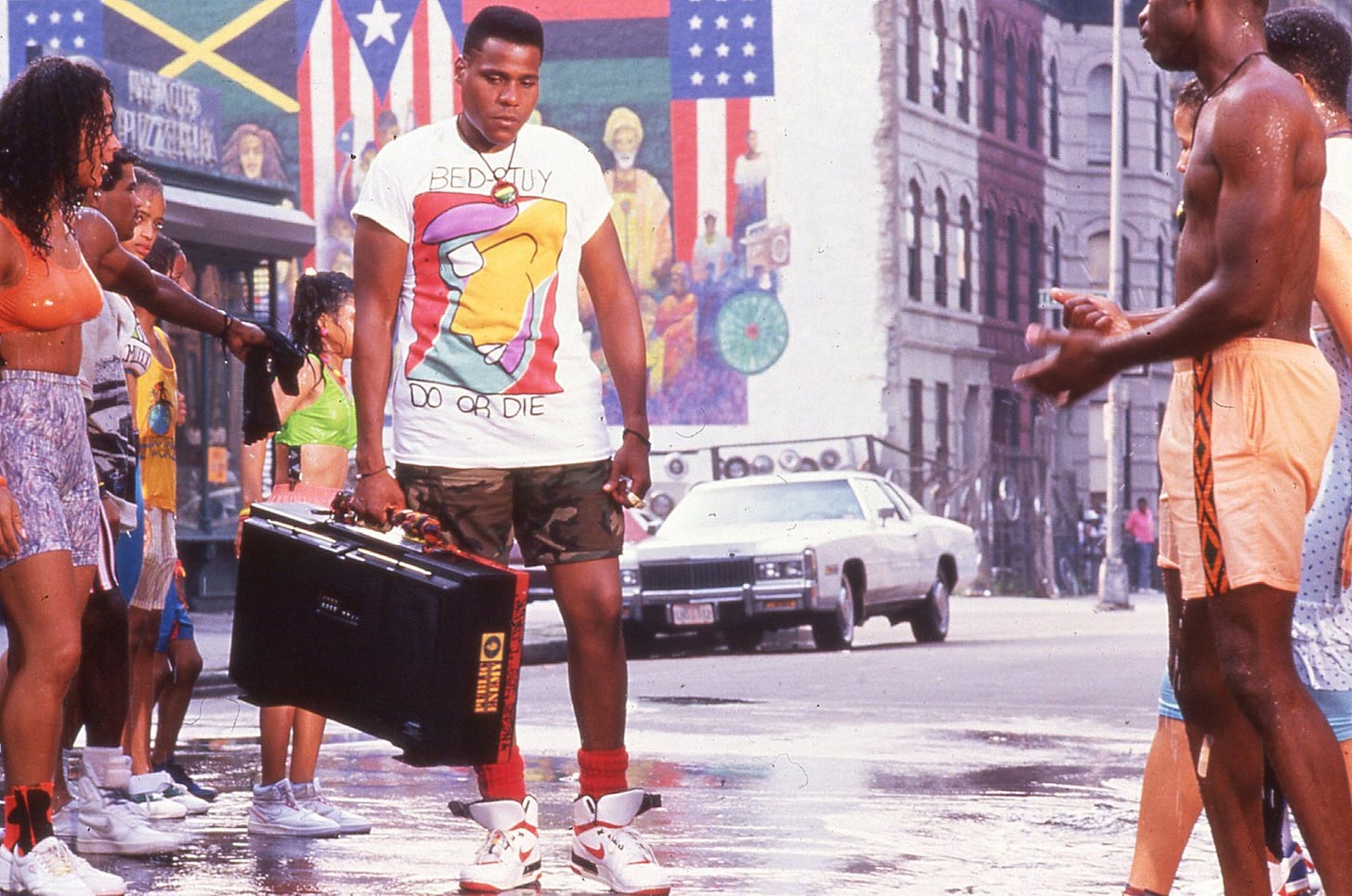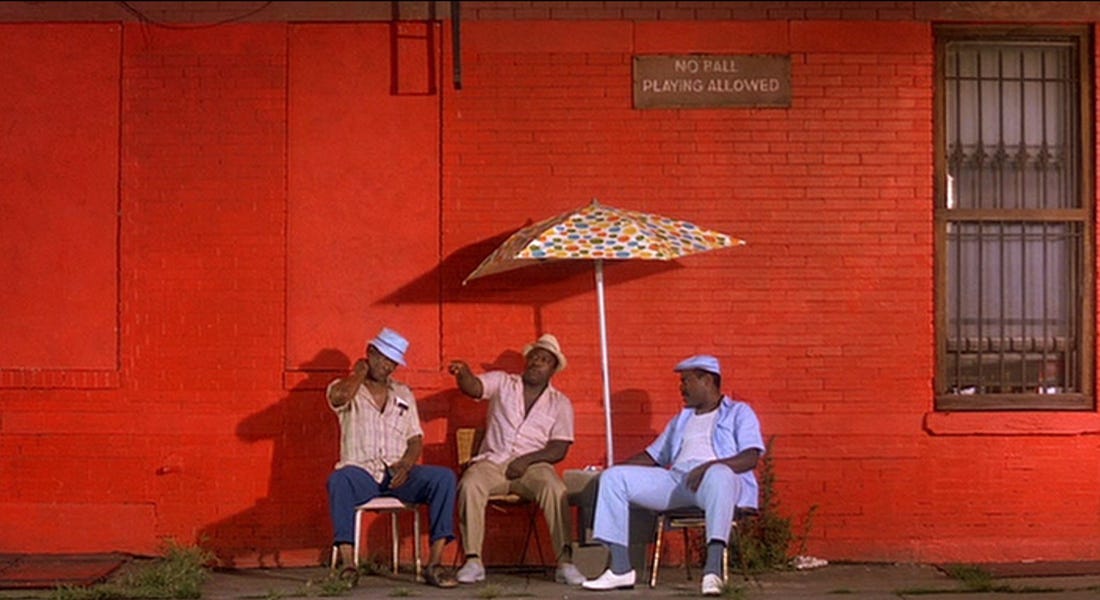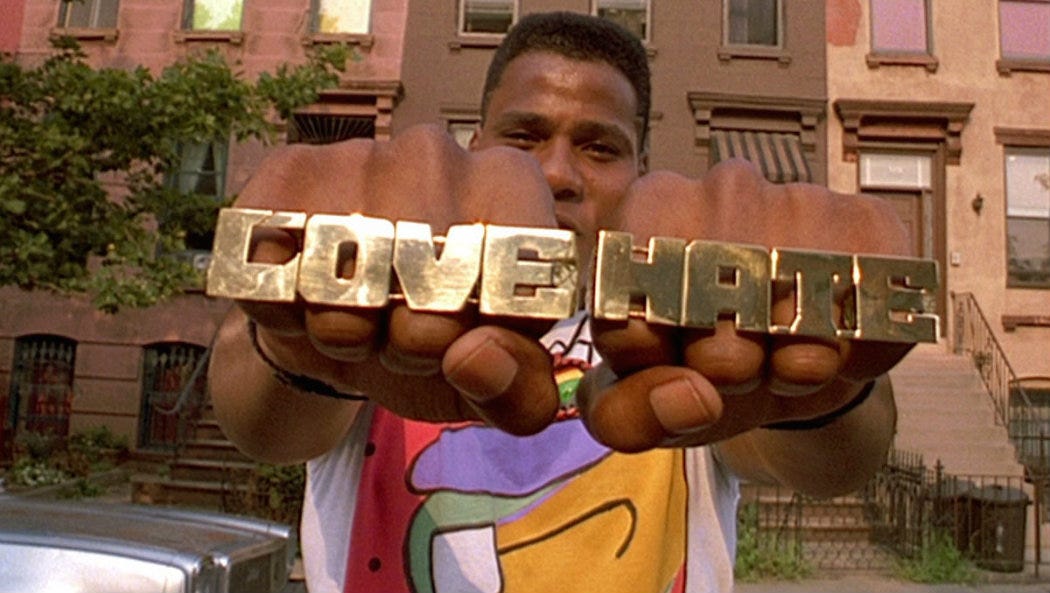Director in Focus: Spike Lee, "Do the Right Thing" (1989)
Continuing a series retracing the films of Spike Lee.
This is the third post in a series focusing on the films of Spike Lee. See the first posts here. Warning: major spoilers below!
Spike Lee’s first two features introduced American cinema to a bold, exuberant new voice—a vital bridge connecting the 1980s (with its tug of war between the last vestiges of New Hollywood and an emphasis on blockbuster entertainment) to the independent scene of the early ‘90s. She’s Gotta Have It (1986) is playful and charming even as it comments on hostilities within the Black community, though its portrayal of main character Nola Darling is far from perfect; School Daze (1988) expands its scope and ambitions, satirizing Greek life at an HBCU in Atlanta. In some ways, these two features reflect Lee’s upbringing, as the writer-director was born in Atlanta, moved with his family to Brooklyn (where She’s Gotta Have It is set), then returned to Atlanta to attend Morehouse College. From the start, Lee showcases the authorial traits that would later define his filmmaking: floridly stylish visuals, a brash and confident tone, didactic dialogue, a volatile mix of comedy, impassioned satire, and (occasionally preachy) drama.
Lee’s stratospheric rise continued with his third feature, Do the Right Thing (1989). By now, this movie has so decisively entered the canon of “Great Films” that its acclaim hardly needs to be recounted. In the 2022 Sight & Sound poll of the best movies ever made, Do the Right Thing ranked 24th, with 87 artists and critics naming it among their favorites. It bears mentioning, though, that the film was met with controversy upon its release, as some thought its explosive ending would incite race riots. It’s a sign of Lee’s clout after his first two pictures that he essentially had carte blanche to film the exact ending he wanted, without any kind of empty platitudes about harmony and togetherness to give the audience easy reassurance. (That said, Paramount Pictures nervously backed out of releasing the film due to its sensitive subject matter, with Universal swooping in to pick up distribution rights.)
It can’t be a coincidence that Do the Right Thing opens with the same exact words that close Lee’s previous film, School Daze: “Wake up.” This time, the words are spoken by radio DJ Mister Señor Love Daddy (Samuel L. Jackson), who serves as not only musical curator but also as voice of reason as things escalate out of control—a sort of one-man Greek chorus. Music plays an integral role in many of Lee’s films (my favorite scenes in his first two pictures are both dance/musical numbers), but it’s especially vital in Do the Right Thing, which opens with mournful saxophone music (composed by Spike’s father Bill, who scored the film’s original soundtrack), plays Public Enemy’s “Fight the Power” over the opening credits, and features several moments in which blaring hip-hop threatens to drown out the dialogue and instigates violent conflicts.
This music serves as the backdrop for the Bedford-Stuyvesant neighborhood in Brooklyn, which threatens to spiral out of control on one of the hottest days of the year. Do the Right Thing is essentially a portrait of a neighborhood, though some of its denizens take a leading role. Mookie (Lee) is a pizza delivery guy in his twenties, which in this case means carrying around pizza boxes as he trudges on foot through Bed-Stuy, often getting distracted by friends and neighbors and taking hours to deliver a single order. His girlfriend is a Puerto Rican woman named Tina (Rosie Perez in her scintillating debut), who accuses him (not incorrectly) of being a deadbeat dad to their infant son, Hector. Mookie’s employers are Sal (Danny Aiello) and his sons Pino and Vito (John Turturro and Richard Edson), Italian Americans who are some of the only non-Black regulars on the block (along with the Korean Americans who own the convenience store across the street).
There’s also Radio Raheem (Bill Nunn), whose life mission is blasting “Fight the Power” as loud as possible on his boombox; Buggin’ Out (Giancarlo Esposito), whose anger at the underlying racism in Bed-Stuy often finds unfortunate outlets; Da Mayor (Ossie Davis) and Mother Sister (Ruby Dee), who appear to be mortal enemies despite the tenderness they obviously feel for each other; Smiley (Roger Guenveur Smith), a mentally challenged man who speechifies on the streets about Malcolm X and Dr. Martin Luther King, Jr., selling photographs of these Black icons; and, last but not least in terms of their destructive impact, the primarily White police officers who intrude upon Bed-Stuy, either keeping the peace or threatening to dismantle it. Do the Right Thing offers a vibrant ensemble—I haven’t even mentioned some of the most pleasurable side characters—that speaks to Brooklyn’s energy and kaleidoscopic beauty, despite the violence and hostility that often take center stage.
It’s the latter that Do the Right Thing focuses on, with the film leading toward a fiery and tragic conclusion. Racial divisions skyrocket throughout the movie, bolstered by the climbing temperatures; the Black residents of the neighborhood are constantly reminded of their powerlessness (surrounded by non-Black business owners, cops, and wealthy neighbors), and it’s inevitable that their frustration boils over, especially following a violent police incident (more on this later).
To state the obvious, Lee’s plea for understanding and sympathy over rage and prejudice is admirable, but I don’t think Do the Right Thing is free of the preachy, awkward dialogue familiar from other Lee films. While the racism in Bed-Stuy is sometimes conveyed in subtle, insidious, everyday ways (like how Pino redirects every order he gets from his dad to either his younger brother or, more commonly, Mookie), more often the film presents these conflicts in blatant, grandstanding scenes rife with on-the-nose dialogue. An interaction between Mookie and Pino in the pizzeria is a good example: Mookie calls out Pino on his frequent use of the n-word1 and argues that Pino secretly wants to be Black; Pino’s response is the speech of a screenwriter, not the words of this character as we know him to exist. A similar weakness hampers the scene in which Sal first argues with Buggin’ Out (before the latter asks Sal why the restaurant’s “Wall of Fame” is populated only with white Italian-American faces); the conflict escalates so quickly that it feels more manipulative than honest. Later, Mookie’s sister Jade (played by Lee’s real-life sister Joie Lee) tells Buggin’ Out, “Yeah, I’m down. I’m down for something positive in the community. Are you down with that?” Reportedly Lee wrote the screenplay for Do the Right Thing in about two weeks, and if he had taken another week to revise some of these didactic, soapbox-worthy speeches, the movie would have been even better.
But immediately after the corny dialogue that Jade utters to Buggin’ Out, the following scene, set in Sal’s Pizzeria, is a visual marvel: the growing tensions between these characters (particularly Mookie and Pino) is conveyed through nothing more than ominously tracking close-ups of the characters, gorgeously achieved by D.P. Ernest Dickerson. Such is the mildly flawed but mostly euphoric experience of Do the Right Thing: some awkward moralizing is vastly overshadowed by singular, jaw-dropping, heartfelt expressiveness.
As a whole, the visual style goes a long way in making Do the Right Thing the truly great film that it is. Dickerson had shot all of Lee’s work up to this point (the two met as graduate students at NYU) and would go on to have a long career as a cinematographer and director, but Do the Right Thing is probably still his finest hour, a stunningly bright and colorful accomplishment that takes full advantage of the cranes, dollies, and other equipment that Hollywood filmmaking could provide. Dickerson and Lee are aided immensely by production designer Wynn Thomas, who revitalized an abandoned stretch of Bed-Stuy (utilizing gallons of red and orange paint, among other things); editor Barry Alexander Brown, who deftly interweaves the film’s numerous characters and subplots; and costume designer Ruth E. Carter, whose work here is a neon, eye-popping time capsule of late-’80s hip-hop style. I wish I could detail all my favorite visual examples—the opening credits, the scenes in which three men chat endlessly against a bright red wall, the intimate close-ups as Mookie rubs ice cubes against Tina’s naked body2—but the best way to witness such a sublime aesthetic is to simply watch the movie.
Maybe more important than the stylistic majesty is the social and political subtext beneath it all. Without a doubt, Lee had ample real-world motivation to make a film about racial hostilities in the US. The closing credits dedicate Do the Right Thing to six Black victims of White violence (Eleanor Bumpurs, Arthur Miller, Jr., Edmund Perry, Yvonne Smallwood, Michael Stewart, and Michael Griffith), and graffiti seen earlier in the film reading “Tawana told the truth!” alludes to the alleged rape of Tawana Brawley. The legacies of Malcolm X and Dr. Martin Luther King, Jr., are overtly mentioned throughout—most vocally by Smiley, but also through two contrapuntal quotes textually displayed before the closing credits: the first, by Dr. King, supports the use of non-violent activism, while the second, by Malcolm X, asserts that political violence when used in self-defense is not actually violence, but merely intelligence. By opposing these two quotes from heroes of the Black liberation movement, Lee questions the use of violence as a political tactic, neither supporting nor denouncing it (to his credit). Where could the Black community go after the Civil Rights Movement, which made some immediate strides but hardly eliminated racial violence in the US and entailed the sacrifice of heroes like King and Malcolm? Do the Right Thing offers a possible, tentative avenue forward, one that infuses the teachings of these two figures.
It’s like the earlier speech from Radio Raheem as he proudly displays his brass knuckles reading “LOVE” and “HATE” for the camera; in this breaking-the-fourth-wall moment, Raheem states that life (and the political battles within it) are a constant struggle between the two:
One hand is always fighting the other hand, and the left hand is kicking much ass. I mean, it looks like the right hand, Love, is finished. But hold on, stop the presses, the right hand is coming back. Yeah, he got the left hand on the ropes now, that’s right. Yeah, ooh, it’s a devastating right and Hate is hurt, he’s down. Left-hand Hate KO’ed by Love.
This might sound like a fairly obvious life lesson, but it’s given infectious energy by Bill Nunn as Raheem, and it becomes more complex when it’s applied to political resistance: love, hate, violence, non-violence, all necessary tactics when your life and dignity are on the line. The title of the movie becomes somewhat ironic: doing the right thing is rarely as clear and easy as it should be.
That makes it especially sobering when Raheem is ultimately the victim of police violence: with tempers reaching a breaking point, a fight ensues in Sal’s Pizzeria, which soon pours out into the streets. Punches are thrown, racial epithets hurled, but the brawl is seemingly containable—at least until the police show up. Several officers (and a White bystander) gang up on the massive Radio Raheem, with one cop pressing his baton into Raheem’s neck. The carnage is unstoppable at this point, and the officer strangles Raheem to death. The police shove his body into the back of a cruiser and hastily drive away, looking to conceal their crime. It’s hardly a surprise that a riot ensues—the residents of Bed-Stuy have no other way to vent their rage at a system that structurally keeps them down through terror and oppression.
Whatever minor flaws Do the Right Thing has, they become irrelevant at this point of the film. Much like Lee’s BlacKkKlansman would do almost thirty years later, the pleasures of fiction and cinematic artistry are suddenly subsumed by the real-life horrors of racism in America. I’m ambivalent toward BlacKkKlansman (a movie I’ll hopefully revisit at some point in this series), but I remember weeping in the theater at its ending, with scenes of chaos in Charlottesville making it incontrovertible how toxic racial violence continues to be in this country.
Do the Right Thing achieves a similar catharsis, as pointed out by the names of victims mentioned in the closing dedication. And not only those names: 31 years after Do the Right Thing was released, George Floyd was murdered by racist police officers in my hometown of Minneapolis, sparking international protests. This took place only a few miles from where I lived, and for the next several years, whenever Minneapolitans saw police officers on the streets, a gang of witnesses would amass and stay vigilant in case another travesty occurred. Of course, many others had succumbed to police violence in the years before and after George Floyd.
If bystanders had had cell phones in 1989, would the murder of Radio Raheem (or other real-life examples) have catalyzed a similar global outpouring? In the face of such an unjust system, how could hate and violence not be logical (if tragic) responses? The same questions that Do the Right Thing asked in 1989 keep being asked in American society over and over and over again. And as long as fascist governments and police forces violently round up citizens (no matter their color, no matter their country of origin), those questions will not go away anytime soon.
Somewhat unfortunately, I feel compelled to return to the supposed focus of this post. Do the Right Thing crystallized at a perfect moment—for American cinema, for a society still mired in the Reagan-H.W. Bush years, for Spike Lee himself. It exploded onto screens and gave voice to a frustrated community that had been voiceless for too long, all through cinematic mastery that infused fresh blood into American filmmaking. Objectively, I might not consider this one of the best movies ever made—I think it does have flaws that prevent it from being a masterpiece. But who cares? Its impact on cinema and countless artists can’t be diminished.
I have to admit that one of my reasons for starting this series in the first place was to determine whether Do the Right Thing is actually Spike Lee’s best movie. Historically, culturally, I think the answer is probably yes; but I’m excited to see whether some of his other works (particularly the under-the-radar, unfairly maligned films that aren’t given enough attention) give DtRT a run for its money. For now, as a wannabe dictator and his pathetic goons drive the USA closer to either civil or international war, I’ll let Mister Señor Love Daddy have the closing words (fitting, since he has the opening words of the film): “My people, my people, what can I say? Say what I can. I saw it but didn’t believe it; I didn’t believe what I saw. Are we gonna live together? Together are we gonna live?”
Next Up: Mo’ Better Blues (1990)
Foreshadowing Lee’s later beef with Quentin Tarantino. More to the point, I will always write “n-word” instead of the word itself, even if writing out those six hateful letters would serve a specific, powerful purpose. Yes, there’s the simple fact that a White writer feeling entitled to write/publish that word is offensive, in my opinion. But it’s more than that. As a writer, I obviously believe that words have power, and the historical recontextualization of that particular word—from a symbol of horrific cruelty when used by White people for centuries, to a (still controversial) symbol of community and belonging when used by Black people—is the most remarkable instance of words’ dexterity and cultural significance in linguistic history. That legacy is more vast and important than any little Substack review I could write, so ergo, it will always be “the n-word” for me.
Perez has spoken about her discomfort filming this scene (in her debut no less). Unfortunately it sounds like Lee, still relatively early in his directing career, didn’t do a great job of making this a comfortable experience for Perez. To focus only on the scene itself, though, it’s one of Do the Right Thing’s most striking and sensuous moments, in large part because the film takes several minutes to slow down, divert from the main plot, and spend time with two larger-than-life characters who seem to love each other, despite their faults.







